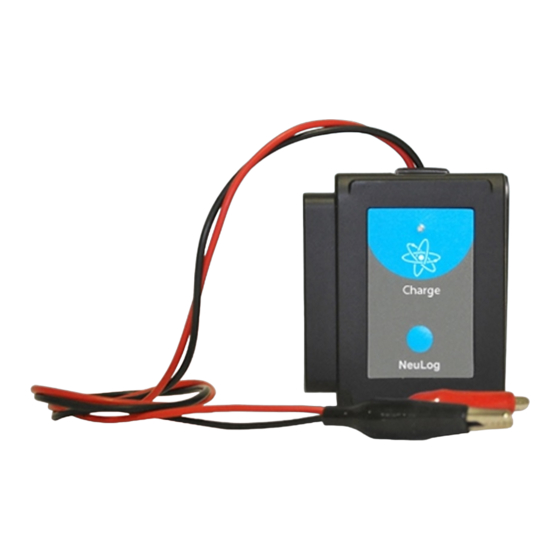
Table of Contents
Advertisement
Quick Links
NeuLog charge logger sensor
NUL-246
The NeuLog charge sensor can be used for any science experiment which utilizes
charge readings such as in the fields of Physics, Electronics, Chemistry, Biology, etc.
The sensor comes pre-calibrated so you can start experimentation right out of the box
using this guide.
The NeuLog charge sensor measures electrostatic charges. It can also be used as a
highly sensitive electroscope – indicating whether a charge is positive or negative.
Just a few of the thousands of possible experimental subjects that can be studied with
the NUL-246 sensor are: explore the nature of static charge, measurements of both
charge and voltage, measurements of charge by induction, quantification of the
charge on a capacitor, discover charge distribution of conducting spheres.
The charge sensor sensor's measurement units are:
Nanocoulombs (nC): A coulomb is the SI derived unit of electric charge.
Millivolts (mV): A volt is the SI derived unit of electric potential.
Quick start procedure:
PC or Mac Computer
Materials needed:
NUL-246 Charge Sensor
USB-200 USB Module
A USB to mini USB cable (included with the USB-200 module)
Your charge sensor needs to be connected to a USB-200 module. The USB-200
module then connects to a computer via a USB to mini-USB cable. Please note that
you cannot plug the charge sensor directly into the computer.
The browser based application can be downloaded for free at
well as a full application user guide.
Choose "Downloads" on the main menu and then choose "Software and Application".
NEULOG CHARGE LOGGER SENSOR GUIDE
Procedure:
1.
Install the NeuLog application.
2.
Connect the USB-200 module to the PC or Mac.
3.
Connect the charge sensor to the USB-200 module (they directly plug together).
Please note that there is no calibration required for this sensor.
4.
Open the NeuLog application by clicking on the shortcut on the screen.
5.
Once a charge sensor module box appears on the left side of the screen the
probe has been automatically identified and you can begin experimentation.
If the charge sensor is not automatically identified, click the "Search for sensors"
6.
icon to find the sensor.
Click on the "On-line experiment" icon; this will open a graph below.
7.
Click on the "Module setup" button located in the charge sensor module box to
8.
change the sensor's settings if need be.
9.
Click on the "Experiment set up" icon to change the experiment settings if need
be (experiment duration for example).
10.
The charge sensor will give a live reading in its module box to the left of the
screen while plugged in.
To run an experiment and collect data click on the "Run experiment" icon.
11.
To end data collection early, click on the "Stop experiment" icon.
12.
Tablet, smart phone device
Materials needed:
NUL-246 Charge Sensor
WIFI-201 WiFi Module
BAT-200 Battery Module
Your charge sensor needs to be connected to a WIFI-201 module. The WIFI-201
module will create a closed NeuLog WiFi network which will stream the NeuLog data
to a device of your choosing. Once your device is wirelessly connected to the NeuLog
network, you can run experiments and collect data through a browser of your
choosing.
Procedure:
www.NeuLog.com
as
1.
Connect the charge sensor directly to the left side of a WIFI-201 (no wires
required).
2.
Connect a BAT-200 module to the right side of the WIFI-201 module.
Advertisement
Table of Contents

Summary of Contents for NeuLog NUL-246
- Page 1 A USB to mini USB cable (included with the USB-200 module) to a device of your choosing. Once your device is wirelessly connected to the NeuLog network, you can run experiments and collect data through a browser of your Your charge sensor needs to be connected to a USB-200 module.
- Page 2 The VIEW-101 will auto detect the sensor and you will see it appear on the left Take your tablet or smart phone, go to the WiFi settings and select the NeuLog side of the screen.
- Page 3 (S/sec) modes in each plastic NeuLog body. This technology allows the sensor to collect and then ±5.000 nC 1 pC store the digital data in the correct scientific units ( F, Lux, %, ppm, for example).
- Page 4 NEULOG CHARGE LOGGER SENSOR GUIDE Thank you for using NeuLog! Maintenance and storage: Never submerge the NeuLog plastic body in any liquid. Do not allow liquid into the charge sensor’s body. After use, gently wipe away any foreign material from the charge sensor.















Need help?
Do you have a question about the NUL-246 and is the answer not in the manual?
Questions and answers